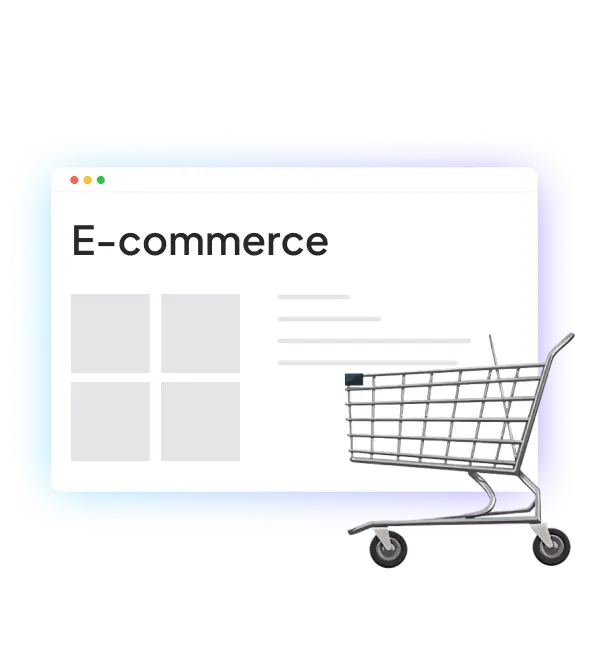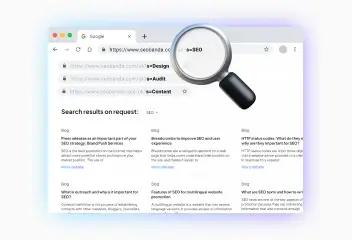What is e-commerce: Definition, types, and benefits
Electronic commerce (e-commerce) is the process of buying and selling goods or services over the Internet. It includes all types of commercial transactions conducted online, from buying physical goods on online stores to ordering digital products and services (SEO promotion, design, etc.). E-commerce can include activities such as online banking, mobile payments, e-tickets, and even auctions.



Why do we need e-commerce?
E-commerce is important not only for businesses but also for consumers. Let’s take a look at the main benefits and opportunities that e-commerce provides:
- Convenience for consumers: E-commerce allows customers to make purchases from anywhere and at any time by providing the ability to order goods or services online. This is especially convenient for busy people or those who do not have access to physical stores. In addition, relevant content also allows for more detailed product information at any time.
- Market expansion for businesses: Businesses can go global by offering their products or services to customers around the world. This allows companies to increase their customer base and revenues without being limited to local markets.
- Reduced operating costs: E-commerce significantly reduces the cost of doing business. The absence of the need to rent retail space, the reduction in the number of staff, and the automation of processes allow companies to reduce costs and increase profitability.
- Personalization of offers: E-commerce allows businesses to collect data about their customers, analyze it, and create personalized offers, which increases customer loyalty and satisfaction.
- Speed and efficiency: Online transactions, ordering, and delivery are much faster than in brick-and-mortar stores. This increases customer satisfaction and allows businesses to generate revenue faster.
- Access to data and analytics: E-commerce provides businesses with the ability to collect data on user behavior, which allows them to better understand customer needs, improve products, and optimize marketing strategies.
- Flexibility and scalability: E-commerce allows businesses to quickly adapt to changes in the market, easily introduce new products or services, and scale their operations depending on demand.
- Increased competitiveness: Thanks to online platforms, businesses can quickly respond to changes in market conditions, stay abreast of trends, and adapt their strategies, which increases their competitiveness.

Increase visibility
for your business: SEO solution for growth!


Types of e-commerce

E-commerce covers different types of transactions between different market participants. Here are the main types of e-commerce:
B2C (Business-to-Consumer)
This type of e-business includes transactions between businesses and end consumers. It is the most common type where companies sell their products or services directly to customers through online stores.
- Example: Amazon, Rozetka.
B2B (Business-to-Business)
B2B e-commerce covers transactions between two or more companies. It can be the sale of raw materials, wholesale supplies, or the provision of services between businesses.
- Example: Alibaba, corporate procurement platforms, business management software.
C2C (Consumer-to-Consumer)
C2C e-commerce allows consumers to sell goods or services to other consumers through specialized platforms. It is a popular way to buy and sell used items or exchange goods.
- Example: eBay, OLX, Etsy.
C2B (Consumer-to-Business)
In this type of e-commerce, consumers offer their goods or services to businesses. This can include selling photos, freelance services, or bids from users in auctions for businesses.
- Example: Shutterstock (image sales), a freelance platform where companies hire professionals for projects.
B2G (Business-to-Government)
B2G e-commerce covers transactions between businesses and government agencies. This can include the supply of goods, services or solutions for government needs.
- Example: Platforms for public procurement, supply of IT solutions for government agencies.
G2C (Government-to-Citizen)
This type of e-commerce involves transactions between the government and citizens. This can be paying taxes, paying for public services, or receiving documents.
- Example: Websites for paying taxes, portals for government services.
M-commerce (Mobile Commerce)
M-commerce covers all types of transactions that are carried out via mobile devices such as smartphones or tablets. It is a convenient way to make purchases, pay bills and receive services anytime, anywhere.
- Example: Mobile shopping apps, payment systems such as Apple Pay, Google Pay.
Social Commerce
Social Commerce includes transactions made through or with the help of social networks. It’s a combination of e-commerce and social interaction where users can make purchases, share experiences, and get recommendations from friends.
- Example: Integration of a store on Facebook or Instagram, links to products in blogs and social media posts.

Increase visibility
for your business: SEO solution for growth!


- Define your target audience: Understand who your potential customers are, their needs, habits, and preferences. Divide your audience into segments to personalize your offers and increase marketing effectiveness.
- Create an attractive and user-friendly website: The website should be user-friendly, with clear navigation, fast page loading, and responsive design for mobile devices. It is important to provide customers with complete information about products or services, including detailed descriptions, high-quality images, and video reviews. Therefore, content creation should be approached professionally, taking into account the semantics in your field. Use keywords, meta tags, and optimize your content for search engines to ensure high rankings in search results.
- Ensure the security of transactions: Having an SSL certificate ensures a secure connection for data transfer between the user and the server, which builds trust in your site. So, use SSL certificates and reliable payment systems that ensure user data protection and secure transactions.
- Optimize the shopping process: The buying process should be intuitive, with a minimum number of steps. Enable quick ordering without registration and offer multiple payment methods, including credit cards, PayPal, bank transfers, and mobile payments.
- Invest in digital marketing
- SEO and content marketing: Regularly create and update content that is interesting to your audience and relevant to their search queries.
- Email marketing: Use newsletters to inform customers about new products, promotions, and other important events.
- Social media: Use social platforms to increase brand awareness, engage with customers, and promote products.
- Maintain a high level of customer service: Ensure that customers can quickly get answers to their questions via chat, phone, or email. Chatbots can help with this, as they will inform customers according to predefined templates.
- Ensure logistics and timely delivery: Choose trusted suppliers and delivery services that ensure timely and safe delivery of goods to customers.


Conclusion
E-commerce definition is buying and selling via the Internet. This process can involve businesses, consumers, and government agencies. E-commerce provides a lot of opportunities and makes business much more convenient for both parties. To successfully run an e-business, you need to create a high-quality website, develop with the help of digital marketing, and ensure security and reliability for users.
You may also like it

Brand identity: The key to brand recognition and SEO success
Every product has its own unique feature that sets it apart from other brands. It could be a special font, a unique mascot, or an interesting logo with the right...

What is a dynamic URL and its impact on SEO
A dynamic URL (Uniform Resource Locator) is a web address that changes depending on the user's request or specific parameters. It differs from a static

Press releases as an important part of your SEO strategy: Brand Push Services
SEO is the best promotion on the Internet that helps attract more potential clients and improve your market position. The use of press releases is an important SEO...












